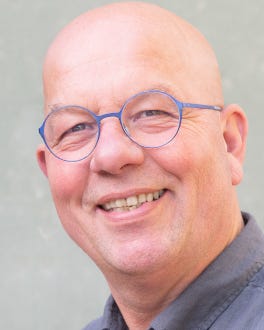Chemical Recycling Offers Additional Source of Food-Safe Packaging
Veteran packaging reporter Erik Kruisselbrink presents news from interpack 2023 of new products and projects centered around plastic packaging and chemical recycling.
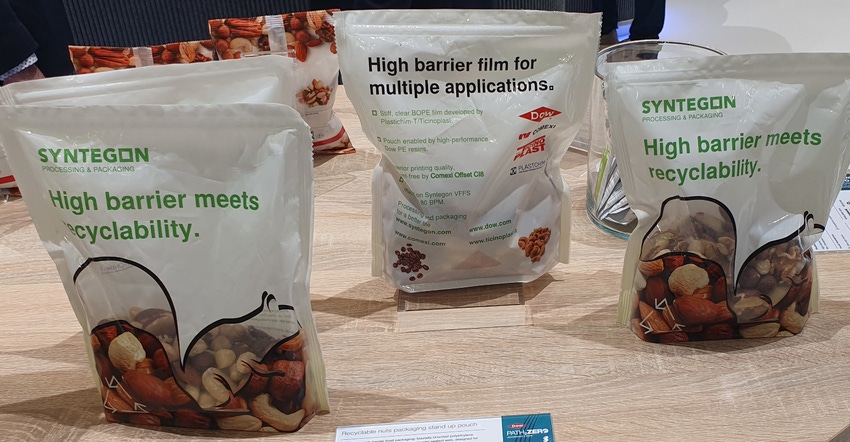
In addition to mono materials with barrier properties, more and more food packaging will soon be introduced after chemical recycling (also called advanced recycling) of packaging waste. In addition, even contaminated, non-food packaging of mixed plastics can be turned into clean food packaging. Oil companies and chemical giants are leading the way. This couldn’t be overseen at the interpack event, held from 4 to 10 May in Düsseldorf.
Chemical recycling from ExxonMobil.
One of the major players that is firmly committed to chemical recycling is ExxonMobil. In addition to being an oil company, this company has been active in the packaging market as a foil supplier for a long time.
One of the developments in this area is the trend towards mono materials with barrier properties for fresh food. Whereas until recently this type of packaging consisted of laminates of composite plastics, more and more variants are appearing on the market in which all the different layers consist of the same type of plastic. Mostly polyethylene (PE). Thanks to technical innovations — for example, by stretching the plastic in different directions — new barriers have been discovered against water vapor and oxygen permeation that cause product spoilage.
At the recently held K show, various products from various major film manufacturers wee already on display showing mono-PE food packaging. However, mono materials are not a suitable solution for all products and a composite laminate will be the only solution against product spoilage in quite a few cases.
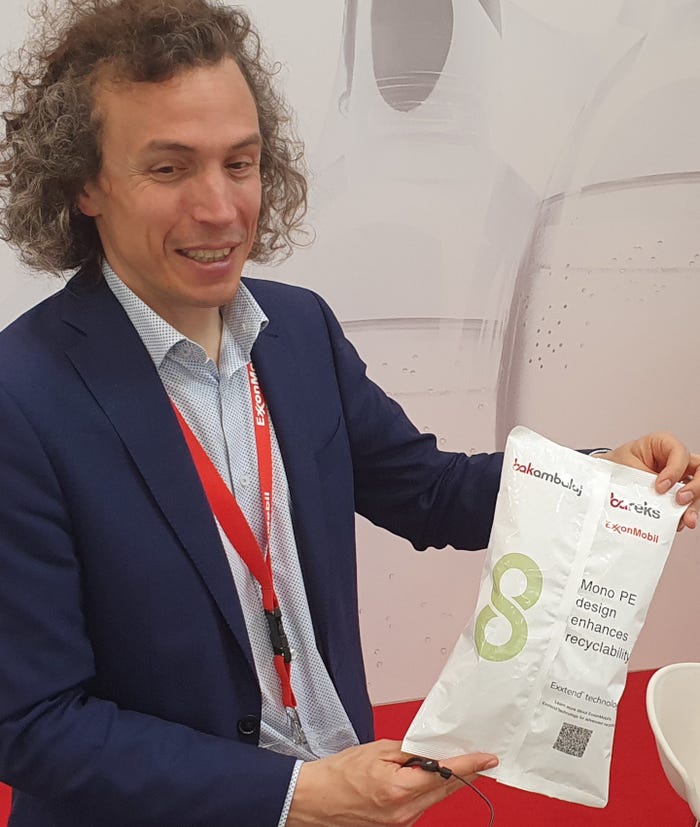
Chemical recycling has been developed to give packaging that was not recyclable until recently a new, second life as a raw material. It is a much more expensive method than mechanical recycling, but it may be the only option if we want to further reduce the amount of plastic waste that can only be landfilled or incinerated. It is no longer just theory, but various large buyers have and spend the money to use this packaging material. Which in turn makes it possible to underline their sustainability ambitions.
New chemical recycling facility in Rotterdam in 2024.
Following the launch in Baytown, Texas, USA, of an advanced recycling plant for mixed composite plastics that cannot be mechanically recycled a plant will also be opened in Rotterdam in the middle of next year and in Antwerp at the end of next year — in addition to other, similar factories in other continents.
ExxonMobil uses patented technology to break down hard-to-recycle plastics and convert them into raw materials for new products. It is capable of processing more than 80 million kilograms of plastic waste per year. ExxonMobil plans to recycle 500 million pounds of used plastics annually by the end of 2026.
Since the start of pilot operations in Baytown last year, ExxonMobil has recycled nearly 15 million pounds of plastic waste. Patented Exxten technology enables the breakdown of plastic waste previously destined for landfills — from synthetic athletic fields to bubble wrap and motor oil bottles.
The company helped found Cyclyx International, a joint venture with Agilyx formed to collect and sort large volumes of plastic waste, and then invested in a plastic waste processing facility in Houston to supply ExxonMobil’s advanced recycling facility in Baytown.
Ahold Delhaize USA.
To accelerate advanced recycling, ExxonMobil is a founding member of the Houston Recycling Collaboration, which brings government and industry together to increase access to recycling programs and expand infrastructure for mechanical and advanced recycling technologies.
ExxonMobil is also working with third parties to assess the potential for large-scale implementation of advanced recycling technologies and opportunities to support improvements to plastic waste collection and sorting in Malaysia and Indonesia.
ExxonMobil has commercial contracts to sell certified circular plastics to customers around the world for use in food-safe plastic packaging, including partnerships with Sealed Air (now known as SEE) and Ahold Delhaize USA, Berry Global and Amcor.
At interpack, the Barek Plastics showed an application in the form of a stand-up pouch for food, but animal feed and other applications are of course also possible.
Exceed S Performance PE.
With Exceed S Performance, ExxonMobil demonstrated a new PE film in various variants, each of which has its own additional properties in a composite mono-PE and therefore recyclable film. For example, Exceed S can be used in bag-in-box liquid packaging, fully PE-laminated food packaging, and heavy bags for polymer granulate.
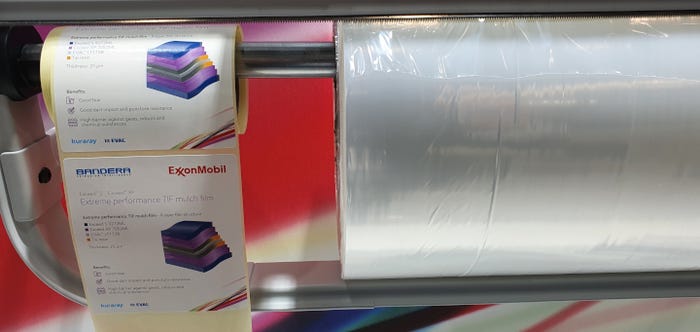
As part of the preparations for a possible market introduction, 80 projects are being tested on a commercial scale. Properties that Exceed S adds according to ExxonMobil are stiffness, toughness, and easy processing thanks to a low melting temperature and thus increased output.
According to the manufacturer, with the addition of this new PE film, the total thickness can be reduced and the amount of high-density polyethylene (HDPE) in a package can be reduced or even eliminated. ExxonMobil claims to improve sustainability because packaging contains less material.
Chemical recycling from Dow Chemical.
Together with Mura Technology, Dow wants to build factories in Europe and the United States for an additional 600 kilotons of chemical recycling by 2030.
In addition, Dow is taking further steps in the field of sustainability, making packaging more circular. For example, in the form of mono materials with barrier functions (see photo at top of page), but also, for example, shrink film for wrapping pallets, which it produces from consumer packaging waste.
For Elopak, for instance, it supplies the biobased PE liner for the barrier that should make the packaging even more sustainable.
Fruit bar in circular PP.
Sabic showed a recently launched flowpack of biaxially oriented recycled polypropylene (BOPP) for the KIND fruit bar from manufacturer Mars. To achieve such recycled and recyclable packaging, Sabic joined forces with snack and animal feed producer Mars and Landbell.

The material is produced from a post-consumer recycled (PCR) mixed plastic waste stream. The process begins with the collection of mixed used plastics coordinated by Landbell. Landbell works with waste disposal company Hündgen to sort the mixed used plastics and supplies the mixed material to Plastic Energy. There it is converted into pyrolysis oil called Tacoil through its patented TAC (thermal anaerobic conversion) process. This pyrolysis oil serves as an alternative raw material for making BOPP granulate approved for food contact by Sabic. This is then delivered to Taghleef, which turns it into foil. Converter SIT Group finally uses the BOPP film to produce printed packaging on a roll for the KIND fruit bars.
Mars has been using BOPP as packaging material for some time, namely for its cat food brand Sheba. But now also for a food product for human consumption.
Pouch made from ocean-bound plastic.
At the Sabic stand, a new pouch made of “ocean” plastic was also on display for the frozen shrimps of the Norwegian company Coldwater Prawns. Sabic worked together with Estonian Estiko Packaging Solutions for this. The pouch is made from a multi-layer film produced by Estiko Packaging Solutions using a circular certified random polymer grade from Sabic PP Qrystal. In addition, 60% ocean-bound packaging waste (OBP) is used.
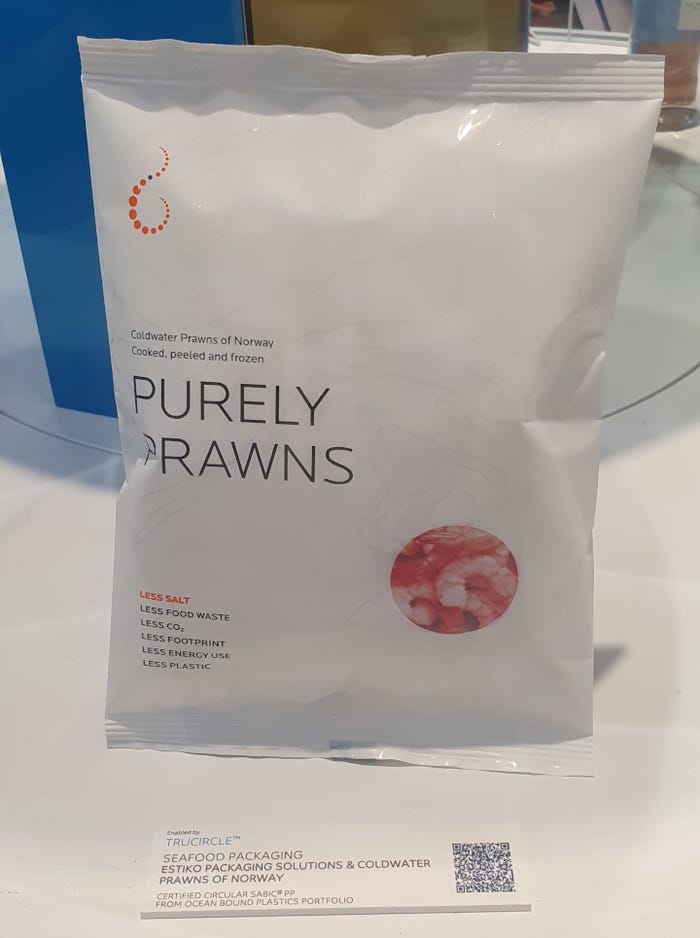
OBP is abandoned or inadequately managed post-consumer plastic waste found on riverbanks and in rivers up to 50 km inland from the coast. In a recycling process, it is converted into an alternative raw material that Sabic uses to produce certified circular polymers that can then be fed back into the material flow for flexible packaging products.
The new packaging is closely aligned with the sustainable harvesting practices of Coldwater Shrimp from Norway. Unlike farm-raised king prawns, the company’s cold water prawns are caught from the deep waters of the Barents Sea, then cooked, peeled, and individually quick frozen (IQF) for packaging and sale.
30% recycled material.
Sabic showed bioplastic lettuce packaging for Bonduelle’s premium range from its Truecircle portfolio. This is now also packed in certified Sabic BOPP film that is produced with a proportion of post-consumer recycled plastic. The BOPP film is made by Vibac and contains 30% recycled material. This lettuce bag is fully recyclable in polyolefin waste streams after use.
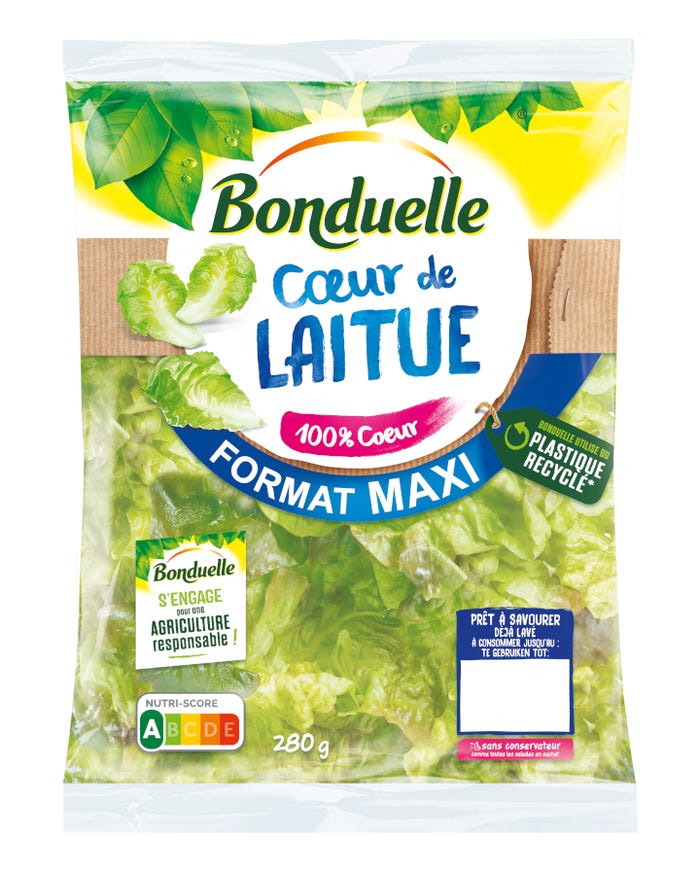
Mono-PE bag for microwave.
But Sabic showed many more novelties at interpack. Including a heat-resistant mono-PE stand-up pouch for products that need to be heated in the microwave.
Thanks to a collaboration with Covestro, a new fully recyclable stand-up pouch was developed, made from Sabic BOPE material, coated with Covestro’s heat-resistant coating resin.
This transparent coating, currently in the pilot phase, has been tested and validated and offers a wider sealing temperature range when processed on form-fill-seal (FFS) lines for flexible packaging. This prevents both shrinkage of the foil during the forming, filling, and closing process and the sticking of the foil to the heat seal bars during the closing of the packaging.
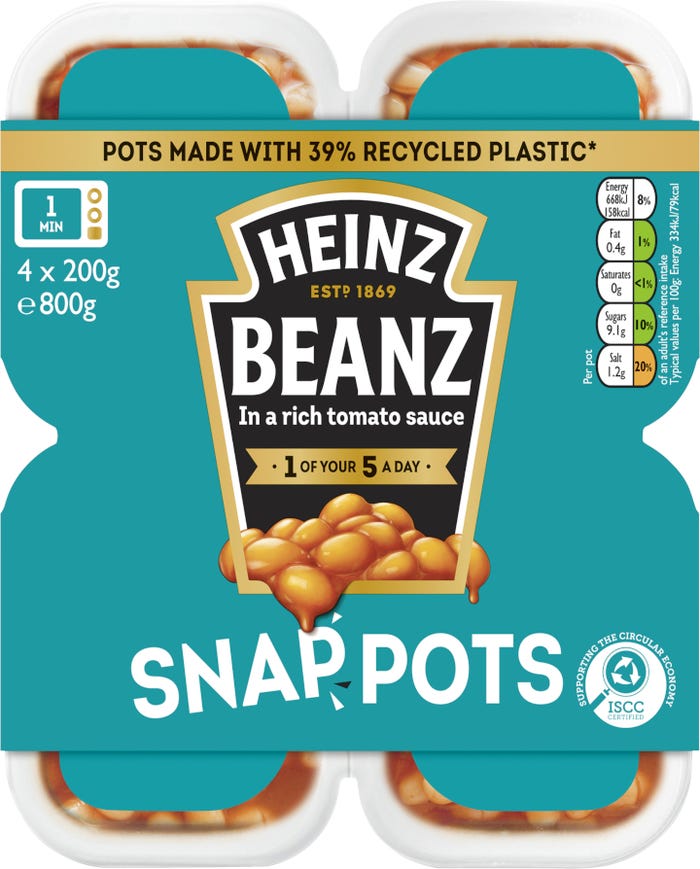
Biomethane replaces naphtha.
Chemical giant BASF showed a new so-called lowPCF product portfolio with a lower CO₂ footprint at interpack. This portfolio consists of various bioplastic products, all of which have biomethane as a raw material, which replaces the standard fossil raw material naphtha.
The lowPCF portfolio currently comprises 18 products. This also includes a bowl of the bioplastic Ultradur for fresh products, such as meat or fish.
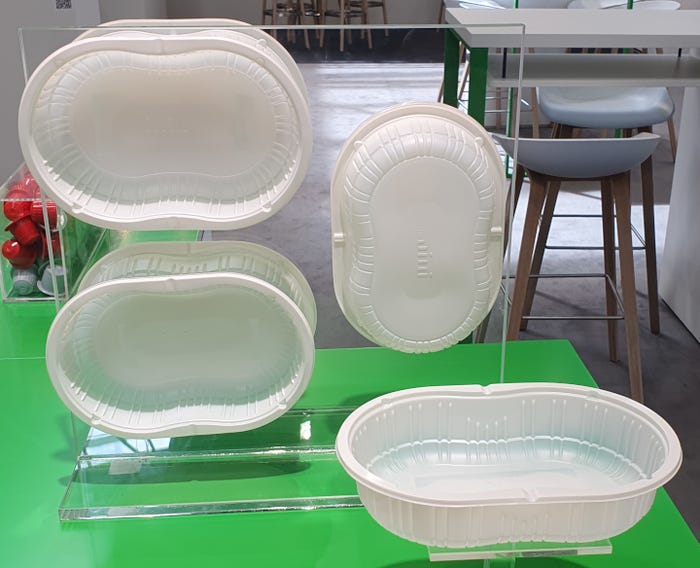
According to BASF, the chemical and physical properties are identical to those of conventional naphtha-based packaging. Due to the already completed certification, the lowPCF products will be available for the European market in the short term. The product is also produced sustainably because green electricity is used in production. Thanks to the composition of the material, the products can only be produced opaque and not transparent.
However, BASF also showed sausage packaging that is the result of chemical recycling of mixed and, if necessary, contaminated plastics, even if they were used in non-food packaging before.
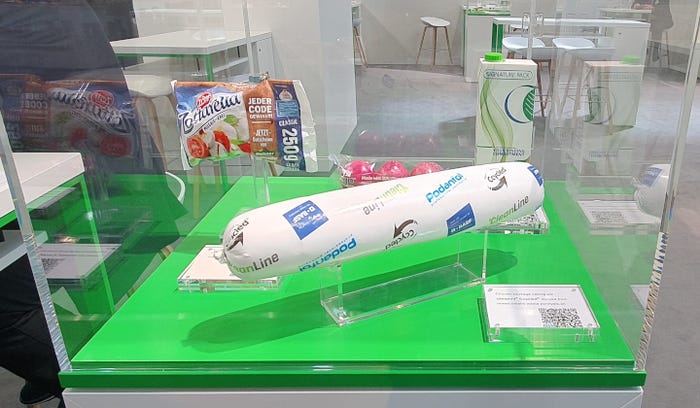
Chemical recycling technology: Hydrolysis PLA.
In addition to various examples of chemical recycling via pyrolysis, attention was paid to a similar process via hydrolysis at the Total stand. In this case of a mono material in the form of polylactic acid (PLA) bioplastic packaging. Total has therefore joined forces with Corbion, with whom it already had a 50/50 joint venture for the production of PLA. The result is a PLA polymerization plant in Thailand with a capacity of 75,000 tons per year.
Corbion supplies the lactic acid necessary for the production of the PLA and the lactide. In the same factory in Thailand, hydrolysis of used PLA packaging is now also being applied, after which it is again suitable for food contact.
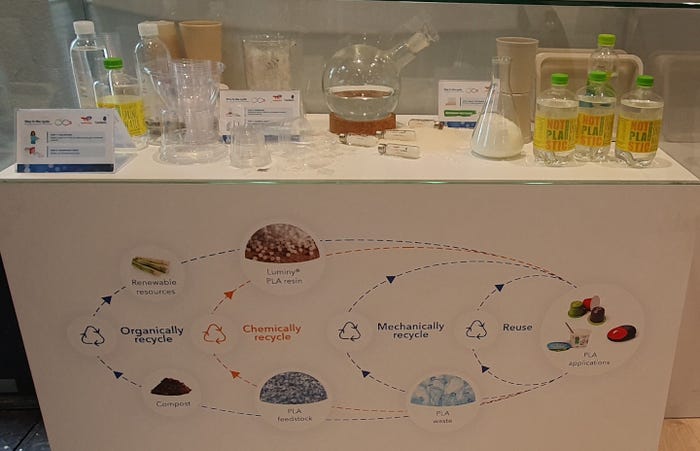
In addition, only a temperature of 60 degrees Celsius is required instead of sometimes tenfold to break down the product. Although the product consists of a mono-material, it can be mechanically recycled, but this is not sufficient for new food packaging. This has everything to do with the contamination and residues left behind in a packaging.
Paper tube from Stora Enso.
In addition to all the examples of chemical recycling and mono materials, paper and paperboard manufacturer Stora Enso gave its own vision on making packaging more sustainable.
For example, it showed a paper tube at interpack, which will be on the market in 2024. Paper-based is a better qualification since the tube of laminated paper consists of at least 85% paper. The inside is provided with a functional moisture barrier.
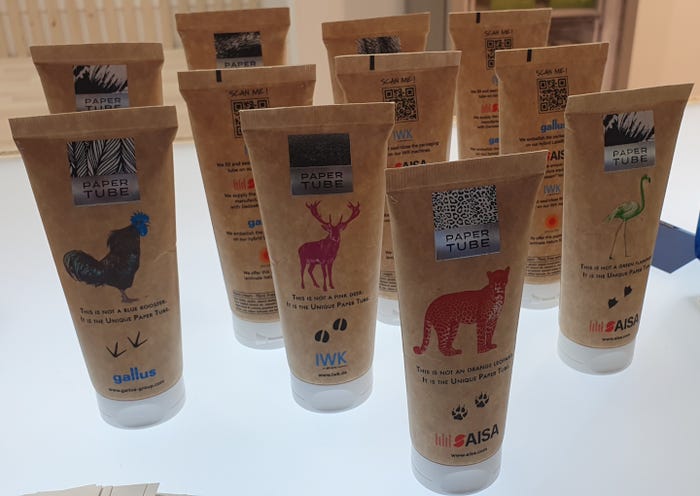
Because the tube consists of at least 85% paper, according to the manufacturer, it can be thrown away after use in the waste bin for paperboard beverage packaging. So, according to Stora Enso, that is where the environmental benefit lies — despite the fact that it is not a mono-material packaging.
In addition to the barrier, the cap is also made of fibre, but Stora Enso is developing a paper-based variant for this. Following the same principle, the manufacturer also exhibited a frozen fruit packaging made of paperboard with a laminated plastic barrier layer on the inside.
About the Author(s)
You May Also Like

